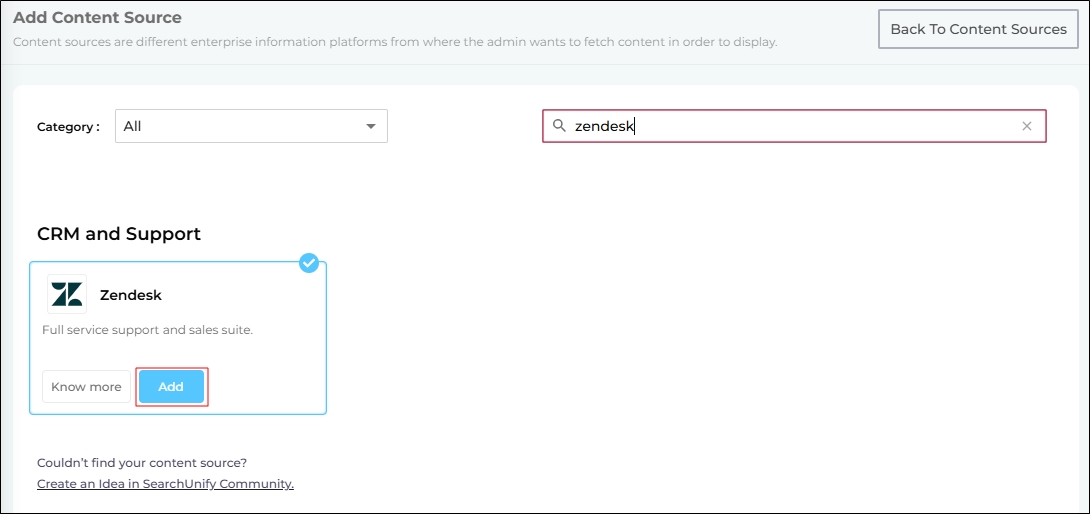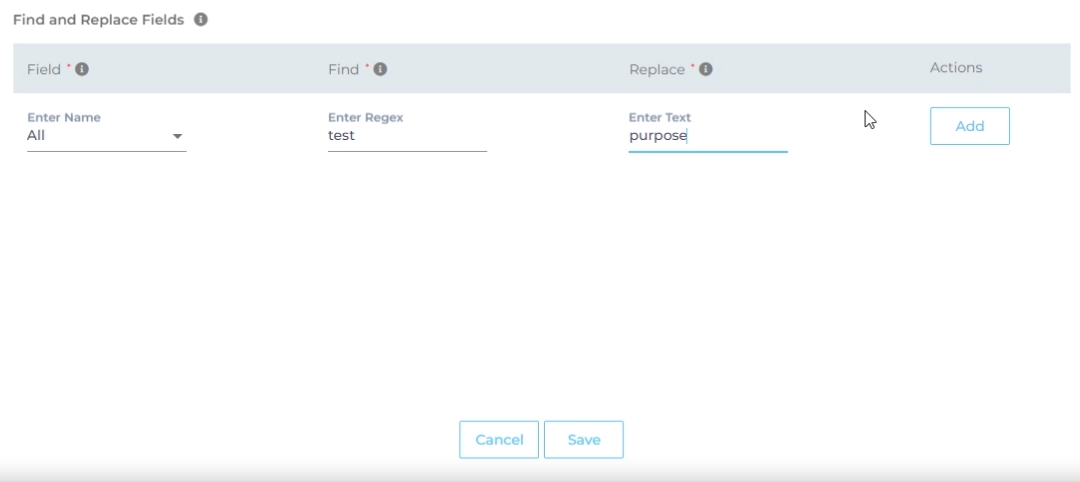Use Zendesk As a Content Source
This article explains how to index the posts, articles, and tickets stored in your Zendesk instance. If you have admin access to Zendesk Community and/or Zendesk Guide, then you can link Zendesk to SearchUnify.
PERMISSIONS.
SearchUnify supports ticket-level content permissions from Zendesk pages.
Enable the help center. It is necessary to crawl data.
Only administrators in Zendesk have the necessary permissions to generate API credentials.
Responses from Zendesk are subject to rate limits. Check out this doc for the current Rate Limits in Zendesk.
Attachment type supported are txt, pdf, doc, docx, ppt, pptx, potx, csv, xsl, srt. Additionally, zip files can be crawled for Articles.
Establish a Connection
-
Find Zendesk and click Add.
-
Under the Authentication tab, enter the required details:
-
Name. Give your content source a name.
-
Client URL. Insert your Zendesk instance web address here.
-
Authentication Method. Select your authentication method. Three options are available:
-
No Authentication
-
Basic
-
OAuth
NOTE.
-
For assistance, check out Which Authentication Method to Select for Zendesk?.
-
If you're using OAuth authentication, it's recommended to log into Zendesk before connecting the content source. Otherwise, you'll be redirected to the Zendesk login screen after clicking “Connect”.
-
If you see a “Connection Failed” message, ignore it and continue logging into Zendesk. Once you're logged in and the authentication is complete, return to the setup screen, enter the Client Secret, and click Connect again.
-
-
Language. Select the language of your Zendesk content.
-
-
After entering the aforementioned details, press Connect.
Once the connection has been set up successfully, you will be prompted to the next action - Set Frequency.
Re-Connect
An admin can edit a Content Source for multiple reasons, including:
-
To reauthenticate
-
To fix a crawl error
-
To change frequency
-
To add or remove an object or a field for crawling
When a Content Source is edited, either a Connect or a Re-Connect button is displayed.
-
Case 1: When the Connect button is displayed:
-
When the Connect button is displayed if the Content Source authentication is successful. Along with the button, a message is displayed There are no crawl errors and the Content Source authentication is valid.
-
Fig. The Connect button is displayed on the Authentication tab.
-
Case 2: When the Re-connect button is displayed:
-
The Re-connect button is displayed when the authentication details change or the authentication fails for any reason.
-
In both cases, the Content Source connection must be authenticated again. To reauthenticate a Content Source, enter the authentication details, and click Re-Connect.
-
Fig. The Re-Connect button is displayed on the Authentication tab.
Set Up Crawl Frequency
The first crawl is always performed manually after configuring the content source. In the Choose a Date field, select a date to start the crawl; only data created after the selected date will be crawled*. For now, leave the frequency set to its default value, Never, and click Set.
Fig. The Frequency tab when "Frequency" is set to "Never".
Select Fields for Indexing
You can choose to index your entire Zendesk data or only selected subset(s) of it. SearchUnify supports the following content types out-of-the-box:
-
posts -
articles -
tickets: SearchUnify can crawl the data stored in Zendesk tickets custom fields.
NOTE
Section data is crawled for articles in nested form. You can use section_category_nested field as nested facets.
- Under the Rules tab, you will land on By Content Type subtab. You can see the list of supported content types here.
- Click
 to select a content type.
You can see the list of pre-configured fields here.
to select a content type.
You can see the list of pre-configured fields here. - Switch to the By Topics subtab.
- Use the index to find your topics. Select the topics you want to crawl.
- Save the Settings.
NOTE. You can add or delete the content fields. Although, it is not recommended for users other than Admins to make any changes in the fields.
You have successfully added Zendesk as a content source in SearchUnify. Perform a manual crawl to start indexing the Zendesk data in SearchUnify.
Related:
Find and Replace
Users on the Q2 '24 release or a later version will notice a new button next to each object on the Rules screen. It resembles a magnifying glass and is labeled "Find and Replace." You can use this feature to find and replace values in a single field or across all fields. The changes will occur in the search index and not in your content source.
Fig. The "Find and Replace" button on the Rules tab in the Actions column.
Find and Replace proves valuable in various scenarios. A common use case is when a product name is altered. Suppose your product name has changed from "SearchUnify" to "SUnify," and you wish for the search result titles to immediately reflect this change.
-
To make the change, click
 .
. -
Now, choose either "All" or a specific content source field from the "Enter Name" dropdown. When "All" is selected, any value in the "Find" column is replaced with the corresponding value in the "Replace" column across all content source fields. If a particular field is chosen, the old value is replaced with the new value solely within the selected field.
-
Enter the value to be replaced in the Find column and the new value in the Replace column. Both columns accept regular expressions.
Fig. Snapshot of Find and Replace.
-
Click Add. You will see a warning if you are replacing a value in all fields.
-
Click Save to apply settings
-
Run a crawl for the updated values to reflect in the search results.
After the First Crawl
Return to the Content Sources screen and click ![]() in Actions. The number of indexed documents is updated after the crawl is complete. You can view crawl progress by clicking
in Actions. The number of indexed documents is updated after the crawl is complete. You can view crawl progress by clicking ![]() (View Crawl Logs) in Actions.
(View Crawl Logs) in Actions.
Once the first crawl is complete, click ![]() in Actions to open the content source for editing, and set a crawl frequency.
in Actions to open the content source for editing, and set a crawl frequency.
-
In Choose a Date, click
 to fire up a calendar and select a date. Only the data created or updated after the selected date is indexed.
to fire up a calendar and select a date. Only the data created or updated after the selected date is indexed. -
The following options are available for the Frequency field:
-
When Never is selected, the content source is not crawled until an admin opts for a manual crawl on the Content Sources screen.
-
When Minutes is selected, a new dropdown appears where the admin can choose between three values: 15, 20, and 30. Picking 20 means that the content source crawling starts every 20 minutes.
-
When Hours is selected, a new dropdown is displayed where the admin can choose between eight values between 1, 2, 3, 4, 6, 8, 12, and 24. Selecting 8 initiates content crawling every 8 hours.
-
When Daily is selected, a new dropdown is displayed where the admin can pick a value between 0 and 23. If 15 is selected, the content source crawling starts at 3:00 p.m. (1500 hours) each day.
-
When Day of Week is selected, a new dropdown is displayed where the admin can pick a day of the week. If Tuesday is chosen, then content source crawling starts at 0000 hours on every Tuesday.
-
When Day of Month is selected, a new dropdown appears where the admin can select a value between 1 and 30. If 20 is chosen, then content source crawling starts on the 20th of each month.
It is recommended to pick a date between the 1st and 28th of the month. If 30 is chosen, then the crawler may throw an error in February. The error will be “Chosen date will not work for this month.”
-
When Yearly is selected, the content source crawling starts at midnight on 1 January each year.
Fig. The content source crawling starts at 00:00 on each Tuesday.
-
- Click Set to save the crawl frequency settings.
-
Click Save.
Data Deletion and SU Index
How is Zendesk's deleted data managed in SearchUnify? Deleted articles and tickets are managed in SearchUnify while deleted posts are managed via webhook in Zendesk.
-
Deleted articles are removed from the SearchUnify index over the weekends. SearchUnify uses Zendesk APIs to remove redundant articles and a maximum of 1000 articles (due to API limit) can be deleted in one attempt.
-
Deleted tickets are removed from the index during frequency crawls.
-
Deleted posts are removed from the searchunify index by webhook, if configured. Refer to this articles on how to configure a webhook in Zendesk - Creating a webhook in Zendesk.
Note. Contact SearchUnify Support to obtain the unique Endpoint URL to be used for creating a webhook. The events needed to be added in the webhook is zen:event-type:community_post.unpublished.
This process doesn't interfere with crawling but it may slow it down. Search and any other Zendesk integrations may be impacted because of the rate limits (check Permissions).
Search Permissions
Search permissions refer to access control on results from a Zendesk content source.
NOTE.
There is no access control when a Zendesk content source is set up with "No Authentication."
Search permissions work when the search user is logged in. Their email is used to identify the user's Ticket group, Article segment, and Post segment. A search user can see all the tickets, articles, and posts in their group or segment. A ticket is visible to a search user outside their group only when the search user is the requester.
When the search user is a Zendesk admin, then all tickets, articles, and posts are visible to them.














